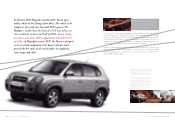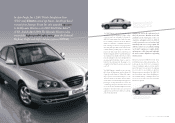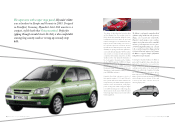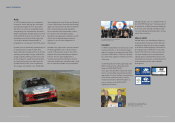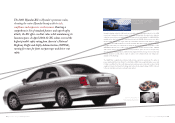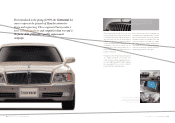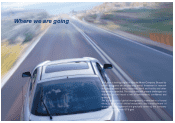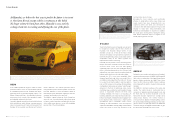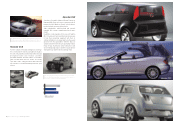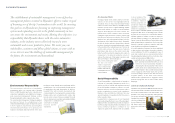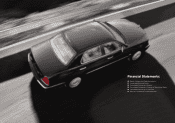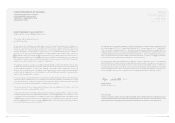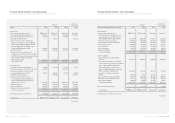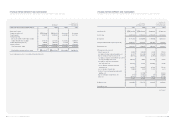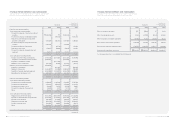Hyundai 2003 Annual Report Download - page 21
Download and view the complete annual report
Please find page 21 of the 2003 Hyundai annual report below. You can navigate through the pages in the report by either clicking on the pages listed below, or by using the keyword search tool below to find specific information within the annual report.
The E3 is the third in a series of Hyundai concept cars to
be designed in Europe and the first creation of
Hyundai’s new European Design Center. A fully
driveable concept car, it hints at the future design
directions of Hyundai’s next generation C-segment car.
Environmentally friendly, unique, practical and stylish, it
encapsulates many of the values Hyundai sees
important in the future of motoring.
Externally the E3 presents a sleek and strong profile.
Unique door frame construction shows the interior to
excellent effect. Front and rear LED lighting
significantly reduces the size of the headlights, allowing
them to blend unobtrusively into the front and rear
styling. Rear view mirrors have been replaced with an
Indicam, which also houses the side marker lights.
Internally, the E3 is even more remarkable. Chief
designer David Finks said of the new model: ‘This is
essentially a car designed from the inside out.’ Its easy
to see why: the E3 has the ability to seat four adults in
real comfort. Unique seat mountings offering multiple
configurations add a spacious and airy “walk through”
dimension to the front. A multi-tiered centre console
containing large, unobtrusive and integrated storage
spaces is “suspended” between the front seats
reaching rearwards. The result is a reassuring, yet
futuristic, grand limousine realized in mass market size.
Intrusive and largely redundant dials and gauges have
been dispensed with, replaced by a multi function
speedometer, plus a retractable centre console
featuring an LCD information screen developed in
conjunction with VDO. A vertically sliding communications
centre also shows a clever way ahead for in-car
communication device storage.
Extending the stress reduction and user-friendly
attention to detail further, all the major climate and
sound controls have been incorporated into one
sculptured control unit which, also developed in
conjunction with VDO and designed to feel good, fall
naturally to hand while being immediately and
instinctively understandable to any driver. In addition
the single spoke steering wheel, holding the airbag,
adds another functional aspect of elegance to an
already imposing interior concept.
Hyundai Motor Company Annual Report 2003 _4039_Hyundai Motor Company Annual Report 2003
In the HCD8 Hyundai has begun to realize its future
potential. It was the car no one expected from Hyundai:
an uninhibited sportscar, bold, beautiful and unique.
Inspired by facets of Hyundai’s flagship vehicles - the
Elantra, Sonata and Coupe - the automaker’s first true
sports tourer is also a result of the automaker’s simple
and unbridled optimism for the future.
“Hyundai’s dramatic growth has been fueled by being
bold and different, while offering customers greater
value at a lower price point,” said Joel Piaskowski, Chief
Designer at the Hyundai’s new Design and Technical
Center, California. “The HCD-8 represents what a
next-generation sports car from Hyundai could be. It is
bold and different. It crosses boundaries within its
intended price point and market segment. It offers the
consumer an alternative to the expected.”
The HCD8 is a great looking car. Sleek, flowing lines
caress the eye. A severely sloped roofline drops away
to form a rounded, muscular rear flank, while the front
of the HCD8 seems almost to scowl. LED headlights
provide state of the art road lighting.
HCD8
The HCD8 with its supercharged 2.7-liter V6 engine, 6-speed manual transaxle and tuned dual exhaust provides performance to match its styling. For real world
driving, the driver can adjust the ride height a total of four inches through the air suspension. The vehicle can sit low for high-speed touring or can be raised to
handle inclement weather, avoid parking wheel stops, handle a car wash or any other situation where additional ground clearance is needed.
Future Brands
The NEOS-II’s two-liter four cylinder mid-mounted engine generates 250bhp and
offers excellent weight distribution and balance for true sports car performance.
In addition the DOHC ‘Beta’ engine is mated to a high-tech six-speed sequential
semi-automatic gearbox, which is both responsive and convenient in operation.
Perhaps the most creative and exploratory of Hyundai’s
next generation prototypes, the NEOS-II (NEologism Of
Style) is the second product of the Japan Design Center
based in Chiba. Unveiled at the 2003 Tokyo Motor
Show, the CUV (Crossover Utility Vehicle) combines
retro styling with the latest in modern technology and
materials.
The NEOS-II is bold and exciting on the inside and
outside. The vehicle’s body is constructed from a
composite of aluminium and thermoplastic resin, and
the front and rear sections incorporate a bio-cell
honeycomb structure engineered to crumple safely
during heavy impacts. The exterior features a
see-round-corners adaptive forward lighting system.
The silver-and-blue trimming and racing car-style seats
give the vehicle a cockpit-style interior; the dashboard
uses both analogue and digital instrumentation to give
the driver all the information he or she needs.
NEOS-II
E-Cubed
The E-Cubed is equipped with a modified 1.8 petrol engine, delivering 140 hp.
The future mass production version of this C-segment car will have as one of its
powerplant options, a 2.2 liter common rail Euro IV compliant diesel engine
that will be introduced sometime between late 2005 and early 2006.
At Hyundai, we believe the best way to predict the future is to invent
it. Our latest fleet of concept vehicles is testimony to this belief.
No longer content to learn from others, Hyundai is now actively
seeking a lead role in creating and defining the cars of the future.




